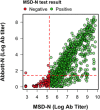This is a preprint.
The Influence of Time on the Sensitivity of SARS-CoV-2 Serological Testing
- PMID: 35194596
- PMCID: PMC8863153
- DOI: 10.21203/rs.3.rs-1286644/v1
The Influence of Time on the Sensitivity of SARS-CoV-2 Serological Testing
Update in
-
The influence of time on the sensitivity of SARS-CoV-2 serological testing.Sci Rep. 2022 Jun 22;12(1):10517. doi: 10.1038/s41598-022-14351-2. Sci Rep. 2022. PMID: 35732870 Free PMC article.
Abstract
Background: Serological testing is used to quantify SARS-CoV-2 seroprevalence, guide booster vaccination and select patients for anti-SARS-CoV-2 antibodies therapy. However, our understanding of how serological tests perform as time passes after infection is limited. Methods: Four assays were compared in parallel: 1) the multiplexed spike, nucleoprotein and receptor binding domain Meso Scale Discovery (MSD) assay 2) the Roche Elecsys-Nucleoprotein assay (Roche-N) 3) the Roche Spike assay (Roche-S) and 4) the Abbott Nucleoprotein assay (Abbott-N) on serial positive monthly samples from hospital staff up to 200 days following infection as part of the Co-Stars study. Results: We demonstrate that 50% of the Abbott-N assays give a negative result after 175 days (median survival time 95% CI 168-185 days) while the Roche-N assay (93% survival probability at 200 days, 95% CI 88-97%) maintained seropositivity. The MSD spike (97% survival probability at 200 days, 95% CI 95-99%) and the Roche-S assay (95% survival probability at 200 days, 95% CI 93-97%) also remained seropositive. The best performing quantitative Roche-S assay showed no evidence of waning Spike antibody titres over 200-days. Conclusions: The Abbott-N assay fails to detect SARS-CoV-2 antibodies as time passes since infection. In contrast the Roche and the MSD assays maintained high sensitivity. The limitations of the Abbott assay must be considered in clinical decision making. The long duration of detectable neutralizing spike antibody titres by the quantitative Roche-S assay provides further evidence in support of long-lasting SARS-CoV-2 protection to pre-existing strains of SARS-CoV-2 following natural infection. Trial registration : Co-STARs study was registered with ClinicalTrials.gov on May 8th, 2020, with trial number NCT04380896 (www.clinicaltrials.gov, NCT04380896).
Conflict of interest statement
Competing Interests:
The authors declare that they have no competing interest.
Figures



References
-
- Evaluation_of_Abbott_SARS_CoV_2_IgG_PHE.pdf.
Publication types
Associated data
Grants and funding
LinkOut - more resources
Full Text Sources
Medical
Miscellaneous

